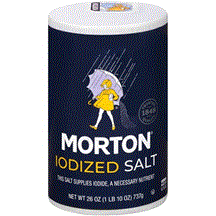 You might have heard of iodized salt, seen it in the grocery store, or even have some in your kitchen right now! But do you know why iodine is added to salt, or even what iodine does for our bodies? Today, I’ll share with you some knowledge on iodine and why it’s important for body functions, especially for pregnant women and infants.
You might have heard of iodized salt, seen it in the grocery store, or even have some in your kitchen right now! But do you know why iodine is added to salt, or even what iodine does for our bodies? Today, I’ll share with you some knowledge on iodine and why it’s important for body functions, especially for pregnant women and infants.
The primary role of iodine is in the thyroid – it is a necessary component of hormones that are released from this gland. These hormones regulate the body’s metabolic rate and controls function of the heart, muscles, and digestive system. They are also vital in brain and bone development. Without iodine, these thyroid hormones would not be made correctly, causing a disorder in which the thyroid does not make enough hormones, or hypothyroidism. This condition leads to weight gain, slower heart rate, fatigue, and an enlargement of the thyroid gland. Iodine is not made by our bodies and must be obtained from the diet, making it important for all of us to make sure we have enough iodine in our diets. It is even more important for pregnant women and their babies, since iodine is needed for proper brain and bone development for the fetus and infant.
What are the recommendations for daily iodine intake? The following numbers were determined by the Institute of Medicine:
o Birth to 6 months: 110 micrograms
o Infants 7-12 months: 130 micrograms
o 1 to 8 years old: 90 micrograms
o 9 to 13 years old: 120 micrograms
o 14 years and older: 150 micrograms
o Pregnant: 220 micrograms
o Lactating: 290 micrograms
Due to the high number of people with iodine deficiency and its negative effects on child development, the U.S. started selling iodized salt in the 1920s. Using iodized salt in your recipes is an easy and cost-effective way to ensure daily iodine intake. Many popular sea salts and pink Himalayan salts do NOT contain iodine, so make sure to double check the label and confirm it has “iodized” printed on it. If you enjoy these types of special salts and don’t want to give them up, consider using iodized salt in recipes like soups, casseroles, and sauces while reserving the un-iodized sea salt or Himalayan salt for garnishes like on top of avocado toast, for example. Additionally, processed and canned foods also normally do not use salt that has been iodized, unless it is listed in the nutrition label.
There are foods that naturally have iodine. Saltwater fish, cod especially, can have significant amounts of iodine. Seaweed is also a rich source of iodine, but the amount varies by species. Shrimp can have some iodine as well. Finally, dairy products and eggs can also be sources of iodine, but the amount depends on the type of feed given to the cows and chickens. On average a cup of milk can have 86 micrograms per cup and eggs can have 26 micrograms.
If you do not eat fish, eggs, or dairy, nor do you use iodized salt, you might not be getting enough of iodine. You can take iodine supplements, which often provide potassium iodide or sodium iodide. Like with other supplements, consult with your care provider before taking, especially if you are on any other medications. If you are pregnant and taking a prenatal supplement and you do not eat any of the foods listed above, ensure that your supplement contains iodine by checking the label. Not all prenatal vitamins contain iodine, and some do not contain the recommended amount for pregnant women.
Resources
1. https://ods.od.nih.gov/factsheets/Iodine-HealthProfessional/
2. https://ods.od.nih.gov/factsheets/Iodine-Consumer/
3. https://www.eatright.org/food/vitamins-and-supplements/types-of-vitamins-and-nutrients/iodine-a-critically-important-nutrient#:~:text=An%20essential%20mineral%2C%20iodine%20is,be%20supplied%20in%20the%20diet.
4. https://link.springer.com/article/10.1007/s00217-012-1693-z
5. https://www.yourhormones.info/glands/thyroid-gland/
